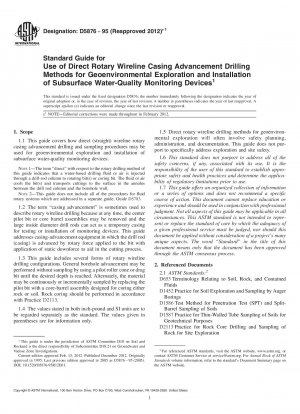ASTM D5876-95(2012)e1
Standard Guide for Use of Direct Rotary Wireline Casing Advancement Drilling Methods for Geoenvironmental Exploration and Installation of Subsurface Water-Quality Monitoring Devices
- Standard No.
- ASTM D5876-95(2012)e1
- Release Date
- 1995
- Published By
- American Society for Testing and Materials (ASTM)
- Status
- Replace By
- ASTM D5876/D5876M-17
- Latest
- ASTM D5876/D5876M-17(2024)
- Scope
- 1.1 Wireline casing advancers may be adapted for use with circulating air under pressure for sampling water-sensitive materials where fluid exposure may alter the core or in cavernous materials or lost circulation occurs (1, 2).3 Several advantages of using the air-rotary drilling method over other methods may include the ability to drill rather rapidly through consolidated materials and, in many instances, not require the introduction of drilling fluids to the borehole. Air-rotary drilling techniques are usually employed to advance the borehole when water-sensitive materials (that is, friable sandstones or collapsible soils) may preclude use of water-based rotary-drilling methods. Some disadvantages to air-rotary drilling may include poor borehole integrity in unconsolidated materials when casing is not used and the possible volatilization of contaminants and air-borne dust. Air drilling may not be satisfactory in unconsolidated or cohesionless soils, or both, when drilling below the groundwater table. In some instances, water or foam additives, or both, may be injected into the air stream to improve cuttings-lifting capacity and cuttings return. Use of water or other additives, or both, should be documented. The use of air under high pressures may cause fracturing of the formation materials or extreme erosion of the borehole if drilling pressures and techniques are not carefully maintained and monitored. If borehole damage becomes apparent, other drilling method(s) should be considered.
5.2 The application of wireline casing advancement to geoenvironmental exploration may involve sampling of groundwater, soil, or rock; or in-situ or pore-fluid testing; or installation of other casings for subsequent drilling activities in unconsolidated or consolidated materials.
ASTM D5876-95(2012)e1 Referenced Document
- ASTM D1452 Standard Practice for Soil Investigation and Sampling by Auger Borings*, 2000-01-01 Update
- ASTM D1586 Standard Test Method for Penetration Test and Split-Barrel Sampling of Soils*, 1999-04-20 Update
- ASTM D1587 Standard Practice for Thin-Walled Tube Sampling of Soils for Geotechnical Purposes*, 2024-04-20 Update
- ASTM D2113 Standard Practice for Rock Core Drilling and Sampling of Rock for Site Investigation*, 1999-04-20 Update
- ASTM D3550 Standard Practice for Thick Wall, Ring-Lined, Split Barrel, Drive Sampling of Soils
- ASTM D4630 Standard Test Method for Determining Transmissivity and Storage Coefficient of Low-Permeability Rocks by In Situ Measurements Using the Constant Head Injection Test*, 1996-04-20 Update
- ASTM D4631 Standard Test Method for Determining Transmissivity and Storativity of Low Permeability Rocks by In Situ Measurements Using Pressure Pulse Technique
- ASTM D5088 Standard Practice for Decontamination of Field Equipment Used at Nonradioactive Waste Sites*, 2002-01-10 Update
- ASTM D5092 Standard Practice for Design and Installation of Ground Water Monitoring Wells in Aquifers
- ASTM D5099 Standard Test Methods for Rubber-Measurement of Processing Properties Using Capillary Rheometry
- ASTM D5782 Standard Guide for Use of Direct Air-Rotary Drilling for Geoenvironmental Exploration and the Installation of Subsurface Water-Quality Monitoring Devices
- ASTM D5783 Standard Guide for Use of Direct Rotary Drilling with Water-Based Drilling Fluid for Geoenvironmental Exploration and the Installation of Subsurface Water-Quality Monitoring Devices
- ASTM D653 Standard Terminology Relating to Soil, Rock, and Contained Fluids*, 1997-04-20 Update
ASTM D5876-95(2012)e1 history
- 2024 ASTM D5876/D5876M-17(2024) Standard Guide for Use of Direct Rotary Wireline Casing Advancement Drilling Methods for Geoenvironmental Exploration and Installation of Subsurface Water-Quality Monitoring Devices
- 2017 ASTM D5876/D5876M-17 Standard Guide for Use of Direct Rotary Wireline Casing Advancement Drilling Methods for Geoenvironmental Exploration and Installation of Subsurface Water-Quality Monitoring Devices
- 1995 ASTM D5876-95(2012)e1 Standard Guide for Use of Direct Rotary Wireline Casing Advancement Drilling Methods for Geoenvironmental Exploration and Installation of Subsurface Water-Quality Monitoring Devices
- 1995 ASTM D5876-95(2005) Standard Guide for Use of Direct Rotary Wireline Casing Advancement Drilling Methods for Geoenvironmental Exploration and Installation of Subsurface Water-Quality Monitoring Devices
- 1995 ASTM D5876-95(2000) Standard Guide for Use of Direct Rotary Wireline Casing Advancement Drilling Methods for Geoenvironmental Exploration and Installation of Subsurface Water-Quality Monitoring Devices
